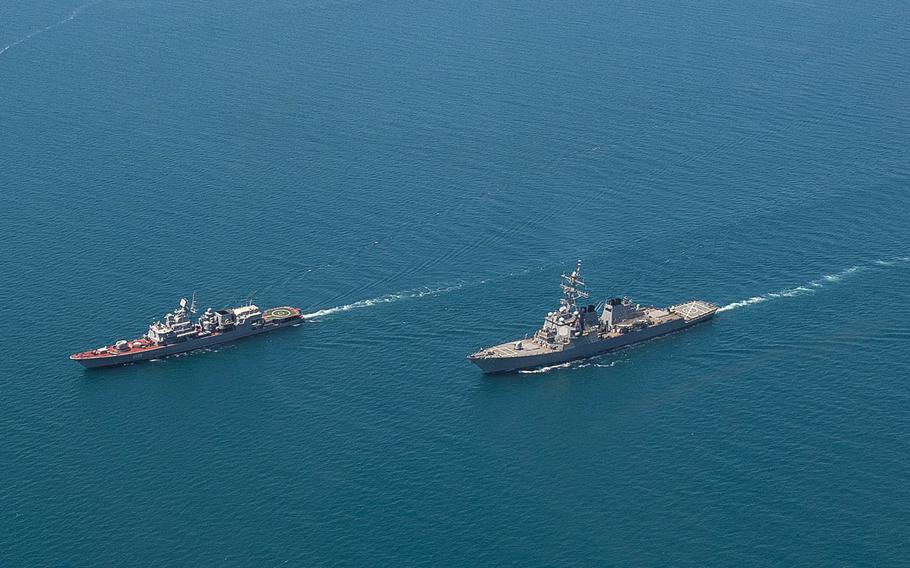
USS Ross, right, transits the Black Sea with the Ukranian navy frigate Hetman Sahaydachniy during an exercise June 2, 2015. The Ross, an Arleigh Burke-class guided-missile destroyer, forward-deployed to Rota, Spain, is conducting naval operations in the U.S. 6th Fleet area of operations in support of U.S. national security interests in Europe. (Robert S. Price/U.S. Navy)
NAPLES, Italy — Russian and American naval officers met recently to discuss ways to prevent collisions or clashes at sea, a growing concern as each side ramps up its presence in Europe following Russia’s intervention in Ukraine.
Held under the auspices of a 43-year-old bilateral agreement on safe operations at sea and in air, the one-day meeting at the American naval base in Naples on Wednesday was the first since the recent rise of tensions in Europe due to Russia’s annexation last year of Ukraine’s Crimean Peninsula, where Moscow’s Black Sea fleet is home-ported.
In recent weeks, there have been several interactions between Russian jets and U.S. ships and planes in and over the Black Sea, including a new U.S. claim that a Russian jet flew to within 10 feet of an Air Force reconnaissance aircraft flying in international airspace.
The meeting here was the latest under a bilateral agreement known as the Prevention of Incidents On and Over the High Seas, which began in 1972 as a Cold War forum for reviewing operations and communicating to avoid conflict or misunderstandings. The last meeting between the two sides was held in November 2013 in Russia, according to the Navy.
Russian Vice Adm. Oleg Burtsev led his nation’s delegation at the meeting, while Navy Rear Adm. John Nowell, chief of staff for U.S. Naval Forces Europe-Africa, represented the American side.
“Discussions between the two delegations were frank and professional with the intent of alleviating any miscues, misunderstandings or miscalculations between our two naval and air forces wherever they might encounter one another,” Vice Adm. James Foggo III, deputy commander of U.S. Naval Forces Europe-Africa, wrote on the command’s website last week.
Foggo later called the discussions “productive” during a roundtable with reporters at a Navy exercise in the Baltic Sea.
Russia is sensitive about American and NATO deployments to the Black Sea, a traditional seat of Moscow’s naval power. The U.S. has sharply increased its deployments to the region, averaging almost one Black Sea visit a month compared to a handful annually before 2014.
The Navy says its ships remain in international waters, unless scheduled for a port call, and follow rules set out by the Montreux Convention, an international agreement that governs foreign warship visits in the Black Sea.
Navy officials have described most of the recent incidents as routine and harmless, with Russian ships and aircraft observing operations from a distance. Few of the interactions have received media attention or even merited it, they say.
But some incidents have sparked concern. U.S. media reported last week that a Russian jet flew to within 10 feet of an Air Force reconnaissance aircraft operating in international airspace over the Black Sea on May 30. Last November, Russian aircraft repeatedly buzzed the American destroyer USS Donald Cook as it operated in the Black Sea.
The U.S. and NATO also say Russian media misrepresents their operations in Europe. Reports out of Russia earlier this month, for example, claimed that Su-24 attack aircraft had been scrambled from Crimea to prevent the American destroyer USS Ross from entering Russian territorial waters. The U.S. Navy denied it was heading toward Russian waters and later posted videos of the aircraft making what it said was a routine side-pass of the U.S. warship “wings clean,” or without ordnance.
The Navy’s current exercise in the Baltic Sea is also gaining its share of interaction with Russian forces, Foggo wrote on the command website.
“During the first day of operations, we were over-flown by Russian air force and shadowed by three Russian navy surface ships,” he said. “This was not unexpected based on recent experience.”
Twitter:@sjbeardsley